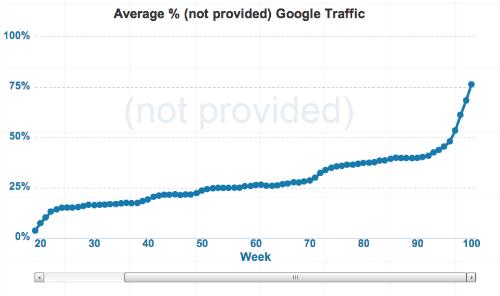If you have a role in digital marketing at your institution you’ve probably heard that Google is rolling out a very significant change to Google Analytics, (GA) that seriously limits your previous capabilities to track keyword search data and trends on your college’s or university’s website. In a nutshell, Google Analytics will no longer provide you with data on keywords that individuals have used in an organic search that led them to your website.
What’s the “Not Provided” keyword percentage on your site?
To find this out, start by pulling up your Google Analytics, All Traffic Report. Look at the Google Organic traffic segment, and then set your secondary dimension to Traffic Sources/Keywords. In the example below, 1348 of the 1656 Google organic search generated visits fall into the “Not Provided ” keyword category. This means 81.4% of the organic traffic going to this college website in September is from what are now unidentified keyword sources.
The current average is around 75% and rising
Over the last two years, Google has been encrypting more and more search data channels (ie logged in Google+ users, Google Chrome Users, etc) thus redefining them as ”Not Provided” in your analytics. The average percentage of a website’s “Not Provided “ keywords today is around 75% but experts suggest that this will rise to 100% in fairly short order. The curve on the following graph from NotProvidedCount.com, which tracks Keyword Not Provided stats, across a broad sample of sites, certainly foreshadows it.
Understanding the keyword source of your website visitors provides useful information about their search intent, helping you to improve the user experience, and for you to optimize your website for visitor conversions on your business goals. In the past, Google Analytics provided all the keywords used in organic searches of your sites visitors, from the most popular “head” terms, all the way down to the rarely used, long-tail search phrases, keywords, for example like, “Queens University”, (branded keywords), to “Personal support worker certificate” (un-branded keywords)”. This very granular detail has been at the core of understanding and carefully segmenting your audience. It has allowed your webmaster to target their work to improve your SEO rankings for the most important keywords by improving your content in these areas. It has allowed you to very directly measure your performance improvements. It has provided the foundation of much of the work done to make your digital marketing effective.
So why has Google implemented this change?
This loss of keyword data really does truly set digital marketers back on their heels in their efforts to manage their SEO and digital marketing. So why is Google forcing this very unpopular change? Well, press releases, theories and rumors abound which basically boil down to two theories that pivot on whether you see Google as a kind and benevolent ruler of the world of search, protector of the individual searcher or as a big corporation carefully controlling their monopoly, intent on driving up Adwords revenue, share value and profits.
Google has stated that this higher level of encryption of keyword search data protects the individual searcher from unwanted observation and or manipulation by third parties. In related news, they have recently had to work very hard to distance themselves from the machinations of the US National Security Agency, (NSA) after being accused of cooperating to give them access to user search data.
On the other hand, others have argued that this change is a simply a means to increase their Adwords revenues. It is important to note that this valuable keyword data is not gone, rather it is now “unavailable” in its past context within GA. It is however available in different shapes and forms within Adwords, including in their recently announced Organic and Paid Report. To get at it there you need to be an Adwords advertiser using your target keywords in your AdWords campaigns to see the organic traffic you previously had access to, at no cost to you in GA.
My guess, as in most things, is that Google’s motives land somewhere in the middle of these two theories. Only time will reveal the full story.
Are there other ways to get at this keyword information?
The good news is yes, there are other ways to get at this information. Some are pretty straight forward but others will push us as marketers to evolve in our thinking on basic SEO towards other metrics like page level insights and business ROI. Other analytics tools like Webmaster Tools, Adwords, and other third party solutions will become more important to us to determine keyword activity. And of course lets not forget that Google controls only 67% of the search market, so other search engines like Bing and Yahoo, still provide keyword search data and may get more advertising dollars and attention as a result.
We’ll discuss the topic of ” How to get at keyword level data from other sources” in next week’s post. Stay tuned to our blog for this, coming soon.
Has your marketing team made plans yet to grapple with the loss of this critical keyword data from your analytics? What tactics have you determined to use to make up for the gap?







